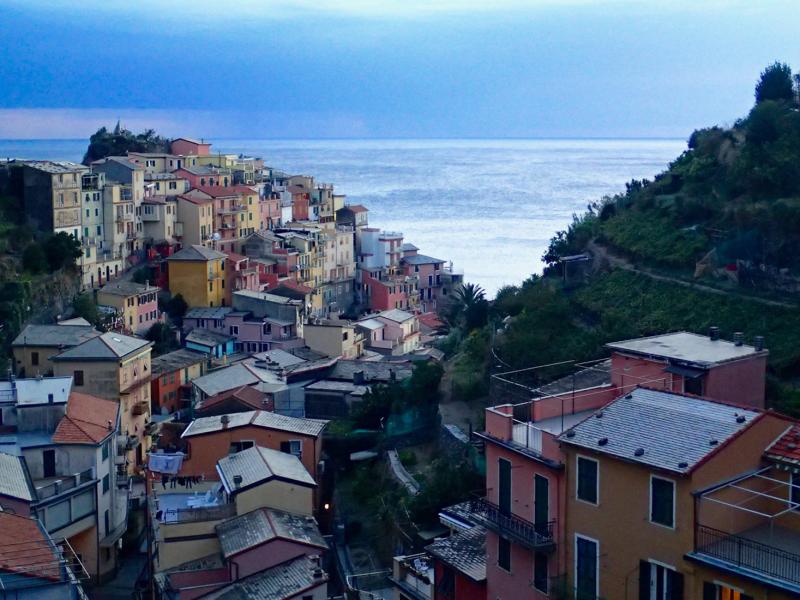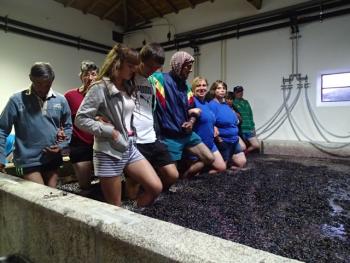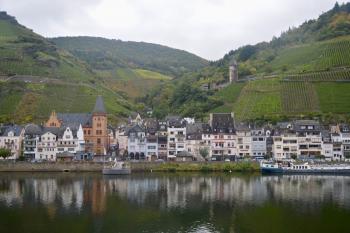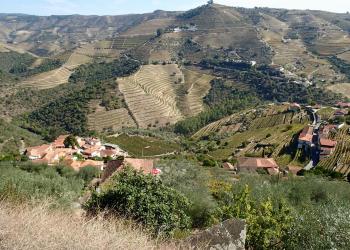Following the grape harvest in Portugal, Italy and Germany
This article appears on page 18 of the December 2016 issue.
We have visited Europe several times in the fall, but never before with the primary objective of experiencing the vineyards at harvesttime.
When planning our 2015 trip, determining which countries to visit was our first challenge, since our travel time was limited to around 30 days. France and Spain were certainly included on the itinerary for their excellent wines and gastronomical delights. Italy and Germany have several wine regions, so they were added, though we had to condense our explorations to specific areas in each country for practicality.
We also chose Portugal, for its scenery, cuisine and port wine (plus we had never been there). It is one of the most affordable countries in Western Europe.
Getting there
As we have written previously (Feb. ’16, pg. 20), the biggest advantage of do-it-yourself (DIY) travel is being able to customize the itinerary to fit your desires. Traveling independently, sometimes unexpected things happen that you (not a tour company) must deal with, but it allows you to have the flexibility to modify your itinerary to spend more time in some places and less in others.
We were able to snag frequent-flyer-award tickets on Delta Air Lines from Little Rock, Arkansas, into Paris and returning from Frankfurt, departing on Sept. 19. To get from Paris to Lisbon, we purchased Air France Economy Classic one-way tickets ($86 per person).
Unfortunately, Air France changed the aircraft, and we were bumped off the flight, apparently due to our discounted fare — not what we wanted to hear after arriving on an overnight flight. The good news was that Air France put us on another flight to arrive in Lisbon only two hours later than planned, plus they credited €250 ($279) each to our credit card.
Two-and-a-half days were allotted for exploring Lisbon and Sintra. In Lisbon, we did a lot of strenuous walking, climbing many steep hills. We also used taxis, which were very inexpensive.
At the Hostel Inn Bairro Alto (Travessa das Mercês no. 52) in the heart of the Bairro Alto, our large, clean room with private bath cost less than $70 per night, including a wonderful breakfast.
Getting around
The three primary areas of Lisbon — Chiado, Bairro Alto and Alfama — were easy to get to using public transportation. We also visited Baixa briefly, but we found it to be very touristy, with crowded shopping and restaurant areas.
The cuisine in Lisbon was delicious, with unusual seafood dishes and homemade pasta at very affordable prices.
Walking to dinner from our hostel, we saw the city's famous Tram 28 but didn't ride it, as people were packed in like sardines — a haven for pickpockets.
We took the train to Sintra to visit the Pena Palace and the National Palace. Both were magical, but we were a bit disappointed because they were very crowded. The city's Castle of the Moors is best seen and photographed from a distance.
Note: seniors can get substantial discounts for train and palace tickets, which are available online from Blueticket (www.blueticket.pt).
After waiting an hour-and-a-half to pick up our rental car from Europcar, we finally headed toward the Douro Valley. If you’re planning to rent a car, you’ll need to do your homework on the Portuguese toll roads. Some toll roads, like A-14, have no tollbooths — hence, no one to take your money — so you must rent a transponder that will automatically charge the rental car company, which will, in turn, charge your credit card. We used the transponder for all tolls in Portugal.
Another danger is the many toll road cameras. If you’re not careful, a few months later you might receive a surprise charge to your credit card! So far, for us, no surprises have been received.
We took our own GPS unit, which gave us warnings on camera locations as well as the locations of petrol stations and restaurants. It was a Garmin portable GPS with US and European maps, and it sold for about $270, as I recall — well worth it. You can rent a GPS with your car, but it can get expensive if you’re renting multiple cars.
Farmstay
We arrived in the town of Lamego to spend the night ($80) at the Quinta da Timpeira (phone +351 254 612 811, www.quintadatimpeira.com), a beautiful upscale quinta (farmhouse) on the outskirts of town. We enjoyed the wine and dinner served at the quinta, which overlooked the valley.
In the morning, we drove to Pinhão in the Douro Valley, famous for its port wines. (Be careful on the high, narrow roads that have hairpin turns and no signs or guardrails.)
We stayed at the Quinta do Passadouro in one of the six rooms in this 400-year-old farmhouse. They grow their own grapes and produce their own wines. Oranges, peaches, figs and nuts are also grown in the area. (We were told they would be closing the B&B, but their winery [www.thewinebowgroup.com] is still open to visitors.)
From the farmhouse, we took day trips to villages and wineries in this gorgeous region along the Douro River. The highlight of each day was coming back to the quinta for a glass of wine and a family-style traditional dinner.
One night in particular was very special. A young writer and wine expert from Frankfurt joined us for dinner. He had come specifically to taste one of the two remaining bottles of a 1955 vintage port bottled and produced at this small winery. He brought four bottles of port from his own collection to taste along with it, plus he ordered two others from the Passadouro’s inventory.
So, after dinner, all 12 guests were invited to smell and sip seven very old wines. The oldest was the 1955 port, and the youngest was a mere 20 years old.
Carol enjoys port wine, but we are by no means wine connoisseurs. However, I must say the aromas and tastes were amazing, unlike anything we had tasted, and we have been in a wine-tasting group for years.
This event was unscheduled, and we were just lucky to be there that night. Even the winery manager said this was a very special occasion.
Another night after dinner, we were invited to mash the port grapes in a vat with the other guests after the workers had finished. Carol was sure to participate. What an awesome experience and a highlight for her!
After our three days, we reluctantly left Pinhão and drove to Nazaré, a beachside town not far from the Lisbon airport. We stayed overnight at Hotel Ribamar (phone +351 262 551 158, ribamar.pai.pt), situated on the beach with our small room facing the ocean, for only $80. We enjoyed local wine and a wonderful seafood pasta dish in the hotel’s restaurant for dinner.
The next morning, we drove to the Lisbon airport to turn in our rental car and fly to Milan, Italy.
On to Italy
We chose to visit Italy’s Piedmont region (rather than Tuscany) for its Barolo and Barbaresco wines as well as for its being the home of white truffles and the “slow food” movement. We have enjoyed Tuscany a few times, but we agree with the many Italians who prefer Piedmont to Tuscany, especially since it has fewer tourists.
The vineyards on the steep hillsides were beautiful, similar to those we saw in Portugal but less rocky and with more greenery.
We had flown on TAP Portugal from Lisbon to Milan but not without stress. Carol was put on standby, probably bumped again due to our discounted tickets (less than $100 each). After some nervous moments, we were able to board together.
We took the Malpensa Express train from Milan’s airport to the downtown area, where we stayed at the inexpensive 3-star Hotel Ritter (Corso Garibaldi, 68; www.ritter-hotel.com). The hotel was dated, but it was centrally located and close to a metro stop, certainly fine for an overnight. We had a fabulous Italian dinner at a small, family-owned restaurant within walking distance of the hotel.
The next day we diverted from our wine harvest theme and took a direct regional train to the Cinque Terre for a 3-day visit, since we had missed that area on previous visits to Italy. Train tickets can be booked online (www.trenitalia.com) at a huge discount. (We paid €9 each for tickets from Milan by booking ahead; the regular price starts at around €20.)
We stayed in an apartment at the top of the small town of Manarola. Situated by the church, our apartment required us to make a very, very steep uphill walk every day, but it offered an awesome “postcard” view.
We had dinner at Trattoria dal Billy (Via Rollandi 122) at the top every night to avoid a post-meal climb back uphill. Reservations there were a must, and the food was amazing. Because the portions were so large, we shared the primo (starter), secondo (entrée) and dolce (dessert) at a cost of €35-€50, without wine.
We used the ridiculously overcrowded local train and the ferry to travel between the five villages. The sheer volume of tourists almost ruined our experience, but we savored what we could. Many tour groups, some from cruise ships, would arrive about 10 a.m., but most would be gone by about 4 p.m.
Wine village visits
Escaping all the congestion, we took a train to Rapallo, where we picked up a rental car for our adventure to Piedmont, where we got back on theme.
We drove to Treiso d’Alba for a stay in an agriturismo in this small village in the Langhe hills. The four rooms at Agriturismo Il Bricco (phone +39 [0] 173 638014, www.agriturismoilbricco.it/farmhouse) are lovely, and a minimum stay of three nights ($100 per night, including an outstanding breakfast) is required.
They have their own vineyards that produce an awesome and inexpensive Barbaresco wine. The owner spoke no English, but her daughter, who was there in the evening, did.
We had a really good time there. We had some days with drizzling rain, but that didn’t keep us from visiting nearby hilltop villages and wineries. We traveled much of the Langhe hills by car, amazed by the very picturesque scenery.
One day, in the village of Barolo, we splurged and enjoyed a heavenly, high-end Barolo wine tasting. Afterward, we had a lunch of risotto cooked in Barolo wine. Awesome!
On two evenings we had dinner at “slow food” restaurants in Treiso d’Alba. Each menu featured simple Piedmontese cuisine served in a small restaurant that seated maybe 25 people. The menu changes every night based on what ingredients are in season. Unfortunately, we missed the white truffle festival by one week.
After our terrific stop in Treiso d’Alba, we drove to Saluzzo on our way back to Milan. Saluzzo is at the base of the Maritime Alps — a beautiful backdrop.
We visited the Villa Bricherasio Botanical Garden, a little-known gem of a garden (admission, €5). It is a tropical oasis at the base of the Alps that offered good photo ops.
After turning in our rental car at Milan’s airport, we overnighted at a small B&B close by. We reached the B&B Il Ciliegio Fiorito ($67 per night, including breakfast) from the airport via the B&B's shuttle (€10).
That night we walked to dinner but got lost. Thankfully, a gentleman rescued us and drove us to the restaurant; the owner’s brother drove us back to our B&B. Wonderful people, the Italians!
The next day we flew from Milan to Frankfurt on Scandinavian Airlines — a pleasant, uneventful experience.
Germany
We chose Germany’s Mosel Valley and Middle Rhine wine regions for their positions along their respective rivers as well as for their beauty. The places we wanted to visit were in a very concentrated area, making it easy to navigate.
Off theme, but certainly worthy of visits, were an abundance of castles and old churches.
We picked up our rental car in Frankfurt and drove to Zell, which would be our home base for the next four days. We rented an apartment a few paces from the Mosel River, the Ferienhaus an der Mosel, which we booked through Booking.com for $70 per night.
This place was fantastic. With a balcony looking over the river, it was a perfect spot to end the day with a glass of wine and cheese. There was also a footbridge to cross over to the town for food and shopping.
Next door were two restaurants, which was convenient when we didn’t want to venture out.
Zell was a very inexpensive village and not touristy. It is centrally located between Koblenz and Trier and is home to Schwarze Katz Riesling wine.
We took day trips to little villages like Cochem, Bernkastel-Kues and Beilstein, home to Burg Eltz, the famous fairy-tale castle admired by Victor Hugo.
The days were slow-paced, with lunches in small, family-owned cafés tucked away in the villages. We visited a few wine shops and wineries, although Riesling is not one of our favorite wines.
After a very relaxing four days, we drove a short distance to Oberwesel on the Rhine River. The villages along the Mosel were much smaller and more picturesque than those along the Rhine. Though still a very beautiful place, Oberwesel was a bit more commercialized and touristy than the other towns we visited.
Our home for the next three days was Gasthaus Weingut Stahl (Am Talblick 6) in Oberwesel-Dellhofen. This small hotel with its own winery cost about $100 per night, including breakfast. The breakfast was generous and offered anything you could want.
Their on-site restaurant was very popular with locals, serving excellent regional meals made with fresh local produce. We had delicious venison and wild boar, and their potato salad and desserts were to die for. The portion sizes were ridiculously large, so we learned to share entrées and desserts. Our shared meals each cost E30-E40 for the two of us, without wine.
We took day trips to small river towns like Boppard and St. Goar. On a rainy day, we drove to Speyer and Worms to see their cathedrals from the 11th and 12th centuries. They were both spectacular, even in the rain.
Winding down
After our stay on the Rhine, we drove on to Mainz to return our car and spend the night before our international flight home. On the way, we took the ferry across the river to Rüdesheim to experience the Drosselgasse, a tunnel-like alley so overloaded with signs that it looked like it could be in Hong Kong. It was very colorful but touristy with the crowds from the river cruise boats. It was a fun time nonetheless.
Then the battery in our GPS died, so, to return our car, we had to locate the Hertz office in downtown Mainz on our own. Fortunately, I had printed directions as a backup plan, and without much difficulty we found it, returned the car and took a taxi to the downtown Hotel ibis (Holzhofstrasse 2). It was a bit blah but fine for an overnight ($100). We picked the hotel because it was a 5-minute walk away from the train stop where we could catch a 20-minute direct connection to the Frankfurt International Airport.
That evening we walked to the pedestrian city center, saw the Romanesque St. Martin’s Cathedral, built about AD 975, and did a bit of shopping. Dinner was in a 200-year-old pub close to our hotel. It had seating for only about 20 in a very confined space.
A young German businessman from Berlin sat with us at dinner. (Sharing your table is common in Germany.) He spoke English, and we had a very nice conversation.
As we did in Italy, the two of us ordered an appetizer and an entrée to share, which still were large portions. We had finally grasped that concept when we were in Piedmont, and it saved some cash.
The next morning we needed a bit of help with the train ticket machine at the station, but, as usual, someone offered to assist. The train ride and our flights home were uneventful.
A few details
This trip met all of our objectives.
The harvest was the center of all activity for each of the small villages we visited. We were able to tour three similar landscapes with very different grapes, wines and cuisine. Watching the grapes being harvested, mostly by hand on steep hills, was very interesting.
The fall foliage of the vineyards was gorgeous. Our timing could not have been better.
We purposely designed our itinerary to be leisurely, with lots of days having no planned activities. The impromptu days were wonderful.
It was necessary to prebook most of our accommodations, since the more popular ones fill quickly during harvesttime. We chose to stay in farmhouses with wineries whenever possible.
The total cost for our 24-day itinerary was less than $6,000, including internal flights and trains. We used frequent-flyer-award miles for our international air travel, with charges only for taxes and fees.
As always, our DIY adventure had its surprises and hiccups, but, overall, it was a fabulous trip. This was a reasonably easy DIY trip to arrange; anyone could plan it with a bit of time commitment. We are very blessed to have our mobility and health, allowing us to continue our adventures.
I will try to answer any questions as my time permits (lc4vino@gmail.com), but I do not design itineraries.




